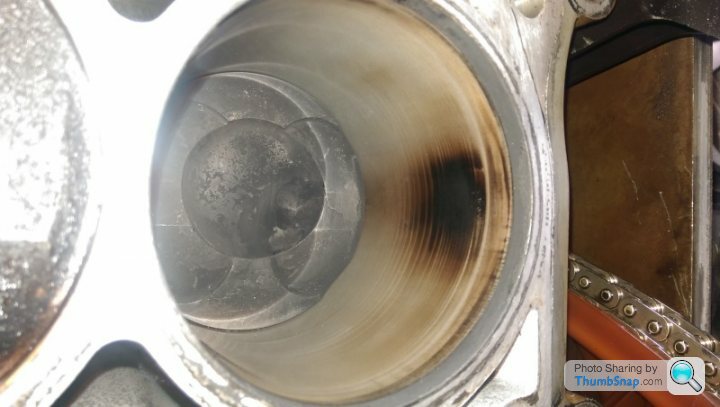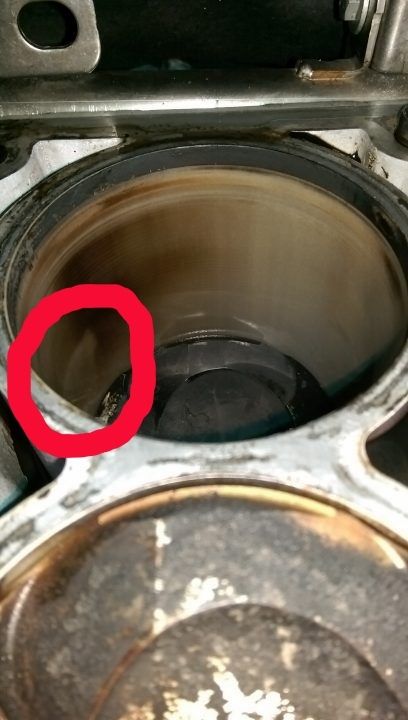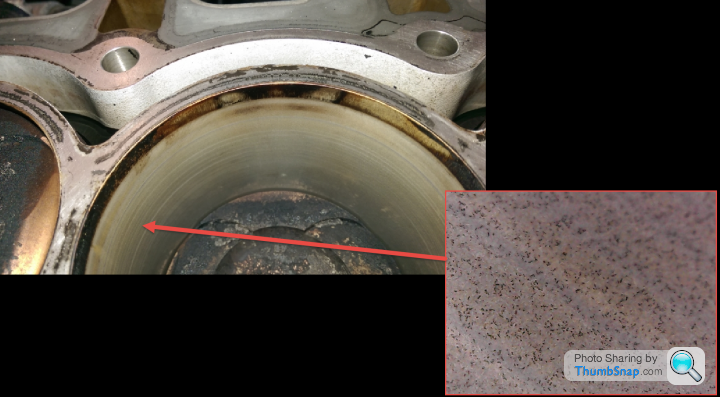High oil consumption and alusil cylinder liners
Discussion
Hi all,
I have been experiencing high oil consumption on my BMW 630i N53 engine and am in the middle of an engine tear down. Cylinders 1 and 6 are where the oil is being burnt. Head is being stripped and inspected by my local machine shop. Found some kind of scorching/carbon deposits on the cylinder walls in 1 and 6 which are not at all present in 2 through 5.
Couple of pics of bores in question here. thoughts/comments appreciated.


I have been experiencing high oil consumption on my BMW 630i N53 engine and am in the middle of an engine tear down. Cylinders 1 and 6 are where the oil is being burnt. Head is being stripped and inspected by my local machine shop. Found some kind of scorching/carbon deposits on the cylinder walls in 1 and 6 which are not at all present in 2 through 5.
Couple of pics of bores in question here. thoughts/comments appreciated.


Edited by viperbluecerb on Monday 30th May 10:26
I can't comment really, other than I found this recently...
http://www.sunnen.com/NewsDetails.aspx?NewsID=11
http://www.sunnen.com/NewsDetails.aspx?NewsID=11
What concerns me is the horizontal line pattern in the first pic which should not be present if the bores had been finished properly. Aluminium bores aren't finished with the conventional 45 degree cross hatch pattern that we are used to seeing in cast iron bores and instead rely on the slight protrusion of silicon crystals to retain an oil film. The new bore surface should be almost glass smooth with a fairly shallow cross hatch pattern due to the slow stroke speed of the honing tool. However those lines in your pic look like boring tool marks which have not been removed by the honing process.
The burnt section is clearly a low spot where the rings weren't seating but I suspect the rings on those two pistons never ran in properly anyway due to the faulty bore finish. The second pic is not at an angle where I can see the bore surface clearly though.
My initial thought is the block was bored too close to finished size and never cleaned up fully in those two bores leading to out of round in places and incorrect surface finish.
The burnt section is clearly a low spot where the rings weren't seating but I suspect the rings on those two pistons never ran in properly anyway due to the faulty bore finish. The second pic is not at an angle where I can see the bore surface clearly though.
My initial thought is the block was bored too close to finished size and never cleaned up fully in those two bores leading to out of round in places and incorrect surface finish.
@Pumaracing, thanks very much for the feedback. I was curious as to the horizontal lines, they are present in all cylinders. Your comments make absolute sense, and I can only assume that the block left the factory this way, something I would like to get BMWs perspective on.
Here is a better picture of the bore on cylinder 6:

Here is a better picture of the bore on cylinder 6:

@stevesingo @Evoluzione, thanks for your comments too, much appreciated.
Searching around I haven't really found much at all on the N53 that has been much help in me diagnosing the problem prior to tear down. PCV system comes up time and again. Some people just accept the high oil consumption as BMW claim anything up to 0.7L per 1000km is acceptable. I wonder how many engines really do have quality issues that are down to unfinished bores if this really left the factory like it.
Searching around I haven't really found much at all on the N53 that has been much help in me diagnosing the problem prior to tear down. PCV system comes up time and again. Some people just accept the high oil consumption as BMW claim anything up to 0.7L per 1000km is acceptable. I wonder how many engines really do have quality issues that are down to unfinished bores if this really left the factory like it.
Edited by viperbluecerb on Sunday 13th March 23:00
Edited by viperbluecerb on Sunday 13th March 23:03
Pumaracing said:
On the full sized pic you can indeed see them. Not so marked as in the other bore but they look exactly like the boring tool marks I would see in iron cylinders as I honed them until sufficient material had been removed.
I can see the bits you mean, but what about these:

That's a very specific shape there, I wonder what caused that? If they bore and hone using tradition style methods I don't see how they could be left like that, it suggests the bore is being squeezed perhaps so that is a high point.
OP, what is on the other side of those shadows in the water jacket, anything?
Seems too obvious, but you never know....
Nothing from BMW that is of any help. Thought I would share this photo just for info. This is a magnification of the bore surface. You can see the silicon crystals as the dark dots that show up. The horizontal rings that are quite visual on the photos cannot be felt by finger or nail in the bore where this magnification was taken. The rings are clearly seen in the magnification, but there is no evidence in the photo that these relate to any kind of ridge or step change in bore surface. The dispersion of the silicon crystals also seems consistent across these ring boundaries.


Not sure of the exact magnification but to give you an idea the spacing between the lines on the image is around 600-700um. The image is also at a slight angle as I couldn't get the microscope orthogonal to to the bore surface.
Measuring the bores reveals up to 50um taper in the most extreme bore (cylinder 6) with circular distortion (measured in parallel and 90 degrees to the crank toward the top of the bore, piston at TDC) as follows:
Cylinder 1: 30um (burn mark evenly split between thrust and non-thrust sides)
Cylinder 3: 40um (no oil burn)
Cylinder 4: 50um (no oil burn)
Cylinder 6: 70um (burn mark on thrust side)
Measured at bottom of bore (piston at BDC):
Cylinder 1: 10um
Cylinder 6: 20um
I am in the process of getting the injectors flow tested and spray patterns analysed. One thing that has crossed my mind is whether a bad injector that is leaking and/or has a distorted spray pattern could be causing some minor bore wash which is sufficient to thin out the lubricating oil on the bore surface such that it burns with the mixture (causing the consumption), but not enough such that metal on metal contact with ring/piston material to bore occurs (causing score marks in the same plane as piston movement). Just a theory, not enough experience with direct injection systems to understand if this is a possibility. Will be interesting to see what the injector tests reveal.
In the meantime, I got feedback on the head. Intake valve guides are fine, but interestingly exhaust valve guides are worn. So while the thing is in pieces it is getting a good clean up of all the coking around the intake valves and ports and new exhaust guides fitted. Which, BTW, you cannot buy as a separate part from BMW - in fact, the machinist can't seem to find out anything about them, so they will have to take an off the shelf item [and modify to fit if necessary]. Seems BMW just want you to buy a new head at ridiculous money :-S
Measuring the bores reveals up to 50um taper in the most extreme bore (cylinder 6) with circular distortion (measured in parallel and 90 degrees to the crank toward the top of the bore, piston at TDC) as follows:
Cylinder 1: 30um (burn mark evenly split between thrust and non-thrust sides)
Cylinder 3: 40um (no oil burn)
Cylinder 4: 50um (no oil burn)
Cylinder 6: 70um (burn mark on thrust side)
Measured at bottom of bore (piston at BDC):
Cylinder 1: 10um
Cylinder 6: 20um
I am in the process of getting the injectors flow tested and spray patterns analysed. One thing that has crossed my mind is whether a bad injector that is leaking and/or has a distorted spray pattern could be causing some minor bore wash which is sufficient to thin out the lubricating oil on the bore surface such that it burns with the mixture (causing the consumption), but not enough such that metal on metal contact with ring/piston material to bore occurs (causing score marks in the same plane as piston movement). Just a theory, not enough experience with direct injection systems to understand if this is a possibility. Will be interesting to see what the injector tests reveal.
In the meantime, I got feedback on the head. Intake valve guides are fine, but interestingly exhaust valve guides are worn. So while the thing is in pieces it is getting a good clean up of all the coking around the intake valves and ports and new exhaust guides fitted. Which, BTW, you cannot buy as a separate part from BMW - in fact, the machinist can't seem to find out anything about them, so they will have to take an off the shelf item [and modify to fit if necessary]. Seems BMW just want you to buy a new head at ridiculous money :-S
Edited by viperbluecerb on Tuesday 22 March 22:02
Evoluzione said:
That's a very specific shape there, I wonder what caused that? If they bore and hone using tradition style methods I don't see how they could be left like that, it suggests the bore is being squeezed perhaps so that is a high point.
OP, what is on the other side of those shadows in the water jacket, anything?
Seems too obvious, but you never know....
That mark would seem to be where the outer wall of the cylinder meets the rest of the block, which is the bottom of the water jacket that is visible from the top of the block. So would make sense that this part would distort differently. I guess temperature differences could also come play.OP, what is on the other side of those shadows in the water jacket, anything?
Seems too obvious, but you never know....
Edited by viperbluecerb on Tuesday 22 March 22:05
Results back from injector testing are very interesting. 5 out of the 6 injectors are junk. These 5 failed the test due to leaking under pressure, with injectors on cylinders 1 and 6 in a really bad state and leaking heavily. Injector 2 was the only injector not observed to be leaking.
Now, when looking back at the cylinder bores, the horizontal marking only appears in cylinders 1 and 3 through 6 - number 2 shows no marking whatsoever, which is the cylinder with the only injector that wasn't leaking. It could well be the case that this leaking of fuel/rich mixture in the cylinders is causing some kind of staining or bleaching affect on the bore walls themselves.
The spray patterns on the injectors looked OK under test, but mixtures are obviously too rich on the affected cylinders, with 1 and 6 the worst. My thought is that this rich mixture is partially washing the oil film off the bore walls causing excess consumption due to it being burnt and replaced on each cycle.
The head should be back from the machine shop on Friday so I will get everything re-assembled. It then looks like a gamble of £1500 on a new set of injectors to see whether my theory is correct and there is no damage that has already been caused which is responsible for the consumption. I don't really have any confidence one way or the other at the moment aside from trying and seeing what happens.
But, one thing I would say - if you have any excessive oil consumption on this N53 engine and/or your OBD tools are reporting O2 range codes, get the injectors checked out - I have been told by the expert that tested mine that these piezo stack based injectors are prone to leakage problems like this due to pintle pitting/corrosion caused by ethanol content of fuel widely used in the UK. Testing cost me just just £35 each injector for those which passed, so in my case £35 for the lot. Well worth it in my opinion.
Now, when looking back at the cylinder bores, the horizontal marking only appears in cylinders 1 and 3 through 6 - number 2 shows no marking whatsoever, which is the cylinder with the only injector that wasn't leaking. It could well be the case that this leaking of fuel/rich mixture in the cylinders is causing some kind of staining or bleaching affect on the bore walls themselves.
The spray patterns on the injectors looked OK under test, but mixtures are obviously too rich on the affected cylinders, with 1 and 6 the worst. My thought is that this rich mixture is partially washing the oil film off the bore walls causing excess consumption due to it being burnt and replaced on each cycle.
The head should be back from the machine shop on Friday so I will get everything re-assembled. It then looks like a gamble of £1500 on a new set of injectors to see whether my theory is correct and there is no damage that has already been caused which is responsible for the consumption. I don't really have any confidence one way or the other at the moment aside from trying and seeing what happens.
But, one thing I would say - if you have any excessive oil consumption on this N53 engine and/or your OBD tools are reporting O2 range codes, get the injectors checked out - I have been told by the expert that tested mine that these piezo stack based injectors are prone to leakage problems like this due to pintle pitting/corrosion caused by ethanol content of fuel widely used in the UK. Testing cost me just just £35 each injector for those which passed, so in my case £35 for the lot. Well worth it in my opinion.
Good update. Don't forget injectors are coded to the cylinders, not sure if you're getting them refurbished or replaced. If refurbished put them back in the same cylinder or you'll have to re input the codes. New ones will need coding. (Some pedants may use a different term to coding).
Either way each injector needs a new decoupling element whenever it is refitted.
Either way each injector needs a new decoupling element whenever it is refitted.
helix402 said:
Good update. Don't forget injectors are coded to the cylinders, not sure if you're getting them refurbished or replaced. If refurbished put them back in the same cylinder or you'll have to re input the codes. New ones will need coding. (Some pedants may use a different term to coding).
Either way each injector needs a new decoupling element whenever it is refitted.
Thanks for the input. Yep, they are all new and will need re-coding, but I have everything I need to be able to do that. Decoupling elements are in the order I have just placed with BMW. £1356 all in. Ouch.Either way each injector needs a new decoupling element whenever it is refitted.
Gassing Station | Engines & Drivetrain | Top of Page | What's New | My Stuff



